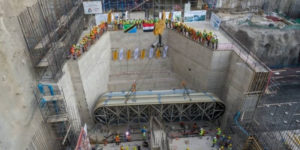by Ben Taylor
Note: we are seeking a new contributor to take over this section of Tanzanian Affairs. If you are interested, please contact the editor.
New gold refineries in Mwanza and Geita
President Samia Suluhu Hassan officially inaugurated the Mwanza Precious Metal Refinery (MMPR) gold refinery on June 13, 2021.
The refinery, which cost TSh 12.2 billion, was built by the State Mining Corporation (Stamico) in partnership with Dubai’s Lozera Company. It has the capacity to process 480kg of minerals per day.
The inauguration ceremony of the factory was attended by residents of Mwanza city, government officials, political and religious leaders.
The Chief Executive of the factory, Anand Mohan thanked the government for the successful completion of construction of the factory and said it will contribute to the growth of the Tanzanian economy.
This followed the completion of Geita Gold Refinery, owned and built by Tanzanian investors, with the help of TSh 18.4bn financing facility from Tanzania’s Azania Bank. The modern gold refinery was built and designed to facilitate operations of all miners from the smallest artisanal one to the largest mining firms in the country.
Data released when the Minerals Minister Dotto Biteko visited the factory in May, shows that the refinery has the capacity of producing 440kg pure gold a day, purifying the minerals to the 99.99% purity.
“Currently, the mining sector contributes handsomely to Tanzania’s Gross Domestic Product (GDP) but it’s been unfortunate that for a long time, gold from Tanzania faces a challenge of quality when it gets to the market and this is why we see the presence of this factory to be a step forward in the government’s initiatives to finding solutions to challenges facing the sector,” said the Minister.
He said the government placed a tender to look for a credible investor who would refine Tanzania’s gold in the year 2016. “34 companies came forward but none of them was able to meet the requirements. When we re-advertised the tender, 16 companies came forward and that was how we picked this investor and we went ahead and gave him the license,” he said.

The Julius Nyerere Hydropower project construction site on the occasion of a visit in August by Medard Kalemani, the Tanzanian Minister of Energy, accompanied by Assem Gazzer, his Egyptian counterpart.
Julius Nyerere Hydropower project
The government will spend TSh 1.4 trillion during the 2021-2022 financial year on the 2,115 Megawatts (MW) Julius Nyerere Hydroelectric Power Project at Stieglers’ Gorge, it was announced in Parliament in June. The money, requested by Energy Minister Medard Kalemani, is 59% of the entire amount that the ministry will spend in its budget for the 2021/2022 financial year.
Seeking MPs’ endorsement for the ministry’s TSh 2.4 trillion budget, Dr Kalemani said activities that will be implemented under the strategic project include; construction of diversion tunnels at the Rufiji River, building the main dam and spill-ways, construction of tunnels, power house and a switch yard. By May 2021, the project whose total cost is TSh 6.55 trillion, had already consumed TSh 2.49 trillion. According to the Minister, its completion was currently at around 52%.
During the coming financial year, the government will also continue with the implementation of a number of other power generation projects, including Ruhudji, Ramakali, Rusumo and extension of the 185MW Kinyerezi I among others. Other focus areas include the construction of the East African Crude Oil Pipeline (EACOP) and Liquefied Natural Gas (LNG) projects.
Dr Kalemani said the country’s power generation capacity has reached 1,605.85 MW, but is projected to reach 5,000MW by 2025, a surplus of 2,323MW over projected demand.
The plan was that the Julius Nyerere Dam would start being filled with water in November 2021 and start generating electricity by June 2022.
[For history of the project see TA120 TA121 TA124]
Large-scale solar power plant in Shinyanga
In Kishapu District, Shinyanga Region, TANESCO will implement the first large scale photo-voltaic (PV) Solar Power Plant of Tanzania. This plant will have a capacity of 50 MW and produce annually 91,600 MWh, in the same time reducing the emissions of greenhouse gas by 22,400 tCO2 eq.
The project has support from the French official aid agency, Agence Française de Développement (AFD), worth €130m. According to an AFD press release, the project represents “an important milestone for Tanzania towards a cleaner and sustainable energy supply and contributes to the necessary fight against climate change.”
According to the International Energy Agency (IEA), in Africa, solar PV is becoming the “new king” of electricity and is forecasted to be the fastest growing source of power generation in Africa by 2040.
Production based on solar has become one of the cheapest energy in the world with increasing performance. Modern PV plants are modular which makes them quick to install and easy to maintain. Operating costs are very low and environmental and social impacts are limited. The source of energy is of free and everlasting.
Solar plants can also contribute to the strategic independence and energy competitiveness of the country, mobilizing local resources and avoiding dependence on fluctuating hydrocarbon prices. Further, Solar PV power plants reconcile development and fight against climate change, producing far less emissions than coal or gas plants.
The challenge with solar power is managing intermittent supplies, with no producing capacity at night and reduced capacity in cloudy weather. The AFD support will include training for TANESCO teams in managing grids supplied by solar power.
